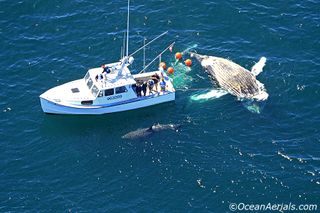
Whales & Sharks from Above: A Fish Spotter's Amazing Tale

Wayne Davis has been spotting fish for 40 years, flying his airplane low over the water in search of bluefin tuna and swordfish. Usually he guides commercial fishermen to them.
But in all of his flights over the Atlantic from his home in Wakefield, R.I., he's seen a lot of other animals, including sharks and whales. And he's taken photographs.
"A lot of people don't believe me when I tell them about seeing these animals in New England," Davis said. The photographs are proof.
Having worked with fishermen since purchasing his single-engine Citabria airplane in 1973, he recently tired of chasing fish. So he has strayed even farther from shore to find whale sharks, hammerheads, great white sharks, basking sharks, humpback whales, mobula rays and other giants of the deep.
He's partnered with underwater cinematographers and researchers to help them film and study these amazing animals. [Images: Sharks & Whales from Above]
Hammerhead close encounter
Two weeks ago, on Aug. 22, Davis helped underwater cinematographers Tom Burns and Eric Savetsky find a school of about 20 hammerhead sharks above Oceanographer's Canyon, 100 miles (160 kilometers) southeast of Nantucket, Mass. Davis saw the sharks from his plane and radioed their position to Burns and Savetsky. They piloted their boat toward the sharks and hopped into the water.
Sign up for the Live Science daily newsletter now
Get the world’s most fascinating discoveries delivered straight to your inbox.
After failing at first to get close to the scalloped hammerheads, which are usually pretty shy, the school approached and surrounded the duo, Savetsky told OurAmazingPlanet. "It was fantastic from a visual experience, but a little unnerving because they were acting bolder than I typically know them to be," he said. But they didn't get too close, and swam off after a couple passes.
"It was an amazing experience, to swim among them, that never would have been possible without Wayne," Burns said.
At some point, Savetsky took his eye off the camera to gauge his surroundings. "When I looked up, there was a 500-pound [230 kilograms] tiger shark about 10 feet [3 meters] away, and I actually screamed into my snorkel," he said.
Savetsky put his camera in front of him not only to film the animal but to protect himself, since tiger sharks can occasionally become aggressive toward swimmers on the surface. Luckily it seemed merely to be curious, and it soon disappeared into the deep.
Finding great whites
Davis has also worked with Greg Skomal, a scientist with the Massachusetts Division of Marine Fisheries, helping Skomal find great white sharks and other animals. On Aug. 27, 2010, off the coast of Chatham, Mass., Davis helped guide Skomal and other researchers to the carcass of a dead humpback whale, which was being circled by a great white.
The researchers tied the humpback whale to the boat and put down a cage to observe the shark up close. This also allowed them to tag the animal, to find out where it spends its time. Sharks are often found near dead whales, which they feed upon.

Davis grew up in New England and was always interested in flying. After serving in Vietnam, he decided to become a spotter pilot and bought his own plane. For 25 years he did hard labor as a deckhand on commercial vessels and worked a fish-spotter in the offseason. Now he just flies.
Skomal said Davis' expertise is invaluable in finding and correctly identifying animals, as is his ability to photograph what he sees. Sometimes Davis will tell Skomal if he finds anything interesting, and other times Skomal will hire Davis to locate animals.
Davis' photographs allow Skomal to know what animals show up where, but they also give an idea of the animals' size and condition. The photograph of the great white, for example, tells Skomal the animal is about 18 feet (5 m) long, as it's half the size of the 35-foot (11 m) boat. The animals are known to reach about 22 feet (6.7 m) in length.
"That was a big one," Skomal said.
Reach Douglas Main at dmain@techmedianetwork.com. Follow him on Twitter @Douglas_Main. Follow OurAmazingPlanet on Twitter @OAPlanet. We're also on Facebook and Google+.
Most Popular


